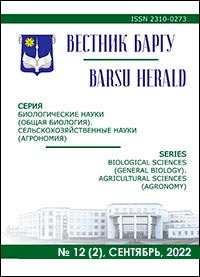CHANGES OF FORAGE VALUE OF SPRING BARLEY DEPENDINGON VARIETY DIFFERENCES AND PHENOLOGICAL PHASES
Keywords:
spring barley; varieties; chemical composition; green mass; grain silage; grain; energy and protein nutritional valueAbstract
The article presents data on the chemical composition of 30 varieties of spring barley of domestic and foreign breeding, in which differences in the content of basic nutrients have been established. An assessment of the energy and protein nutritional value of the green mass of barley at the early stage of development of full tube production showed that the content of exchangeable energy in fodder varieties is 9.5—10.2 MJ. A change in the productivity of green mass and its nutritional value depending on varietal characteristics and phenological phases (according to the ВВСН scale) have been established. The collection of dry matter during the growing season changes upwards until the beginning of the wax ripeness of the grain and amounts to 96—112 c / ha. When full ripeness is reached, its yield decreases to 74—86 c / ha, depending on the variety.
A comparative assessment of the quality indicators of grain silage harvested from different varieties of barley is given. Its energy nutritional value is 9.5—10.7 MJ with a crude protein content of 134—142 g per 1 kg of dry matter of the studied varieties.
The results indicate the high quality of the green mass of fodder barley and the wide possibilities of its use in the green and raw materials conveyor, taking into account varietal characteristics of soils typical of the republic.
Downloads
Published
Issue
Section
License
Copyright (c) 2023 Вестник БарГУ Серия "Биологические науки. Сельскохозяйственные науки"
Это произведение доступно по лицензии Creative Commons «Attribution-NonCommercial» («Атрибуция — Некоммерческое использование») 4.0 Всемирная.
Авторы сохраняют за собой право заключать определенные договорные соглашения, касающиеся неисключительного распространения опубликованной версии работы (например, размещать ее в институциональном репозитории, публикация в книге) со ссылкой на ее первоначальную публикацию в этом журнале.





